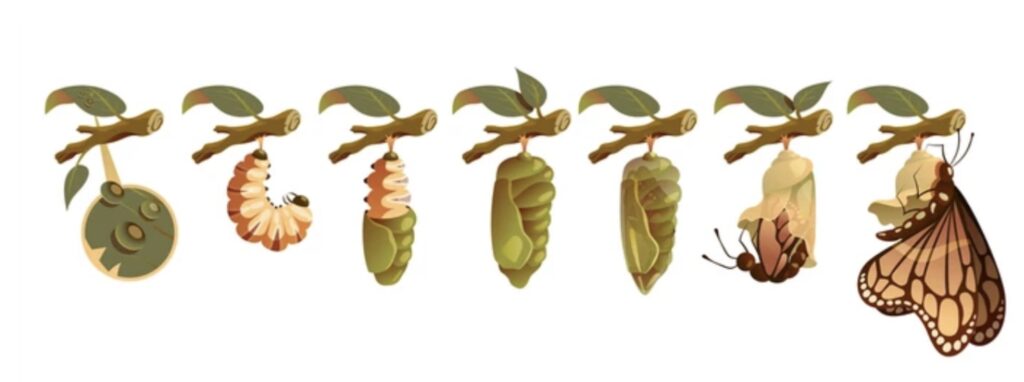INTRODUCTION
Metamorphosis in insects is a fascinating biological process that showcases the remarkable adaptability and complexity of these creatures. It refers to the series of distinct developmental stages an insect undergoes during its life cycle, typically involving a transformation from egg to larva, pupa, and finally adult. This phenomenon is not only crucial for the survival and reproduction of insects but also plays a significant role in shaping ecosystems and influencing human societies in various ways.
LIFE CYCLE OF INSECT

The life cycle of an insect typically begins with the laying of eggs by an adult female. These eggs can vary greatly in size, shape, and structure depending on the species of insect. Some insects lay their eggs individually, while others deposit them in clusters or masses. The location where the eggs are laid also varies, ranging from terrestrial environments to aquatic habitats and even within the bodies of other organisms in the case of parasitic insects.
EGG STAGE
Once the eggs hatch, the newly emerged insects enter the larval stage. Larvae are often very different in appearance and behavior from the adults of their species. For example, caterpillars are the larval stage of butterflies and moths, and maggots are the larvae of flies. Larvae are typically specialized for feeding and growing, as this stage of the life cycle is primarily focused on accumulating the resources needed for the insect to complete its development.
LARVAE STAGE
As larvae grow, they undergo a series of molts, shedding their exoskeletons to accommodate their increasing size. This process, known as ecdysis, allows the insect to continue growing and developing. In some cases, larvae may undergo dramatic changes in body form during each molt, while in others, the changes may be more subtle.
Once the larval stage is complete, many insects enter the pupal stage. The pupa is a transitional stage between the larval and adult forms and is often characterized by the formation of a protective covering known as a pupal case or cocoon. Inside this case, profound changes occur as the larval tissues are broken down and reorganized to form the structures of the adult insect. This process, known as metamorphosis, is controlled by hormones and genetic programs that orchestrate the transformation from larva to adult.
METAMORPHOSIS IN INSECTS

Metamorphosis can take various forms depending on the insect species. In some insects, such as butterflies and moths, metamorphosis is complete, meaning that the larval and adult forms are distinctly different from each other. These insects undergo a radical transformation during the pupal stage, with the larval tissues being almost entirely broken down and rebuilt into the adult structures. The transition from caterpillar to butterfly, for example, involves the formation of wings, legs, and other adult features that were absent or rudimentary in the larval stage.
In contrast, other insects undergo incomplete metamorphosis, where the transition from nymph to adult is more gradual and involves fewer morphological changes. Insects such as grasshoppers, crickets, and dragonflies undergo incomplete metamorphosis, with the nymphs resembling miniature versions of the adults and gradually developing wings and reproductive organs as they molt and grow.
ADULT STAGE
The adult stage of the insect life cycle is typically focused on reproduction, as this is the primary goal of most adult insects. Once mature, adults seek out mates and engage in behaviors such as courtship displays and mating rituals to ensure successful reproduction. In some species, adults have highly specialized adaptations for finding mates, such as pheromones or elaborate mating dances.
After mating, females lay eggs, often in specific locations that provide suitable food and shelter for the developing larvae. This completes the life cycle, and the process begins anew as the next generation of insects emerges from the eggs and begins its journey through the stages of metamorphosis.
Metamorphosis in insects serves several important ecological functions. By occupying different ecological niches at different stages of their development, insects can exploit a wide range of resources and habitats, contributing to ecosystem diversity and stability. For example, the herbivorous larvae of butterflies and moths may feed on one type of plant, while the adults may feed on nectar from a different set of plants, reducing competition between the two stages.
Additionally, metamorphosis can help insects evade predators and parasites by temporarily occupying cryptic or inaccessible habitats during vulnerable stages of their development. The protective pupal case or cocoon provides a physical barrier against predation, while the rapid changes that occur during metamorphosis may make insects less recognizable to predators that target specific prey types.
Furthermore, metamorphosis plays a significant role in shaping human societies and cultures in various ways. Insects have long been a source of fascination and inspiration for humans, appearing in art, literature, and mythology throughout history. The symbolism of transformation and rebirth associated with metamorphosis is evident in myths and folklore from cultures around the world, reflecting the profound impact of this phenomenon on the human imagination.
SIGNIFICANCE
In addition to their cultural significance, insects play essential roles in ecosystems as pollinators, decomposers, and prey for other organisms. Understanding the mechanisms of metamorphosis and the factors that influence insect development is therefore crucial for the conservation and management of insect populations and the ecosystems they inhabit.
CONCLUSION
In conclusion, metamorphosis is a remarkable biological process that shapes the lives of insects in profound ways. From the humble egg to the graceful adult, insects undergo a series of transformations that enable them to adapt to diverse environments and fulfill their ecological roles. By studying metamorphosis, scientists can gain insights into fundamental principles of development and evolution, while also appreciating the beauty and complexity of the natural world.
Discover more from ZOOLOGYTALKS
Subscribe to get the latest posts sent to your email.


